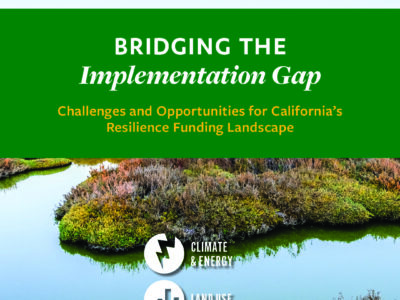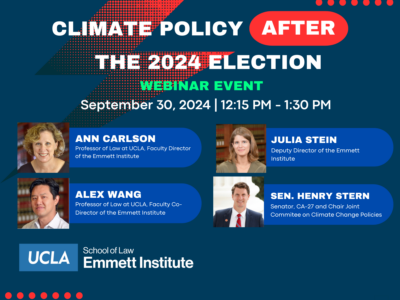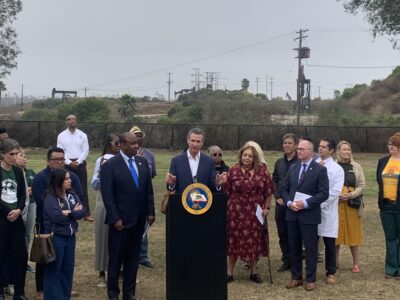California
Is California’s Climate Resilience Funding Ready for the Future?
New CLEE Report Identifies Key Challenges and Opportunities in the State’s Adaptation Funding Landscape
As climate change accelerates, California faces increasingly severe threats to its communities, economy, and environment. Rising temperatures, prolonged droughts, sea-level rise, and worsening wildfires are among the risks stretching State and local resources and driving demand for adaptation funding. California has utilized its longstanding leadership in climate policy to confront these challenges, including developing the …
Continue reading “Is California’s Climate Resilience Funding Ready for the Future?”
CONTINUE READINGNo More ‘House of Horrors’ Thanks to These New Laws
Several California laws prohibiting dangerous chemicals from household products go into effect on or after January 1, 2025.
Halloween is the one time when we welcome ghouls, ghosts, and goblins coming to our homes (and, if your neighborhood is anything like mine, a variety of tiny superheroes). This season, however, the Legislature is dealing with a different kind of house of horrors: dangerous chemicals in everyday products that affect millions of Californians’ health. …
Continue reading “No More ‘House of Horrors’ Thanks to These New Laws”
CONTINUE READINGClimate Policy After the 2024 Election
In this UCLA Emmett Institute webinar, panelists discussed the climate implications of the 2024 election from the state, national, and international perspective.
Climate certainty. Legislative action. Whipsaw regulations. An exodus of civil servants. Chinese leadership despite being the world’s largest emitter. Those are a few of the possible outcomes of the Nov. 5 presidential election, according to our panelists. More than in any previous election, the two major candidates’ track records on environmental policies are well-established and …
Continue reading “Climate Policy After the 2024 Election”
CONTINUE READINGNew Law Reaffirms Local Authority to Ban Oil Drilling
AB 3233, part of a trio of bills that the governor just signed, paves a clear path for local phase-out efforts.
This morning, Governor Newsom signed a trio of bills—AB 3233 (Addis), AB 1866 (Hart), and AB 2716 (Bryan)—that will protect communities in Los Angeles and across the state from the harms of oil and gas production, the impacts of which are disproportionately experienced in low-income communities of color across the state. He signed the package …
Continue reading “New Law Reaffirms Local Authority to Ban Oil Drilling”
CONTINUE READINGCommunity Solar: Compensation
Who gets the money? Compensation mechanisms are where a lot of the power of these programs resides, but naturally, also the debate.
This post is co-written by Naomi Caldwell (J.D. ’24, UCLA School of Law). Two recent posts explored community solar through the lens of its many potential benefits. (Part One on systemwide benefits and Part Two on local and individual benefits.) Today’s post follows the money, exploring community solar compensation mechanisms. The question of who makes …
Continue reading “Community Solar: Compensation”
CONTINUE READINGElectric Shared Mobility:
Program Design Elements Can Produce More Equitable, Durable, and Successful Projects
Shared mobility—an umbrella term for any transportation mode shared among multiple passengers—has the potential to accelerate transportation electrification, air quality, and greenhouse gas reduction goals, meet the needs of underserved communities that most lack mobility access, and advance broader mobility equity goals. CLEE’s report, Electric Shared Mobility: California Lessons Learned for Equity in Program Design, …
Continue reading “Electric Shared Mobility:”
CONTINUE READINGCommunity Solar: Local and Individual Benefits
Community solar offers a rich case study for how a diverse range of values can be integrated into the traditionally narrow scope of public utility commission decision-making.
Earlier this week, I published a blog post highlighting some of the systemwide benefits community solar programs can provide and exploring considerations for policy design prioritizing each benefit. Today’s post continues that project, this time focusing on several of the benefits community solar can generate at the local or community level and for individual households: …
Continue reading “Community Solar: Local and Individual Benefits”
CONTINUE READINGCommunity Solar: The Systemwide Benefits
The debates over community solar program design are fascinating sites of struggle over which values should drive decision-making.
Electricity regulation has traditionally been defined by a relatively narrow public interest prerogative: ensuring just and reasonable rates for reliable electric service. The call to decarbonize, however, has injected a new diversity of values into the conversation. Transforming the electric power system to reduce greenhouse gas emissions is opening new opportunities to elevate values like …
Continue reading “Community Solar: The Systemwide Benefits”
CONTINUE READINGAssessing the First Decade of California’s Sustainable Groundwater Management Act
You’re Invited to “10 Years In: A SGMA Report Card”–A Conference at U.C. Davis Law School on 9/6
A decade ago, California stood out–and not in a good way–as the only Western state without comprehensive state laws monitoring and regulating groundwater pumping and use. But in 2014, following years of severe and protracted California drought, and both agricultural and urban water users compensating for depleted surface water flows by pumping groundwater in unprecedented …
Continue reading “Assessing the First Decade of California’s Sustainable Groundwater Management Act”
CONTINUE READINGLosing Chevron: What Does It Mean for California?
The Supreme Court’s decision in Loper Bright will not necessarily impact how California courts review our state agency determinations. But we’ll feel it in other ways.
A question I’ve been getting a lot since the Supreme Court overturned the Chevron doctrine is: “What does this decision mean for California?” Here are three takeaways about how the Golden State is likely—or not—to be impacted at first blush. First, the decision does have the potential to impact California directly in some pending litigation. …
Continue reading “Losing Chevron: What Does It Mean for California?”
CONTINUE READING













